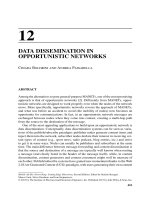Hacking ebook mobile device exploitation cookbook over 40 recipes to master mobile device penetration testing with open source tools
Bạn đang xem bản rút gọn của tài liệu. Xem và tải ngay bản đầy đủ của tài liệu tại đây (9.36 MB, 227 trang )
Free ebooks ==> www.Ebook777.com
www.Ebook777.com
Free ebooks ==> www.Ebook777.com
Mobile Device Exploitation
Cookbook
Over 40 recipes to master mobile device penetration
testing with open source tools
Prashant Verma
Akshay Dixit
BIRMINGHAM - MUMBAI
www.Ebook777.com
Mobile Device Exploitation Cookbook
Copyright © 2016 Packt Publishing
All rights reserved. No part of this book may be reproduced, stored in a retrieval system, or
transmitted in any form or by any means, without the prior written permission of the
publisher, except in the case of brief quotations embedded in critical articles or reviews.
Every effort has been made in the preparation of this book to ensure the accuracy of the
information presented. However, the information contained in this book is sold without
warranty, either express or implied. Neither the authors, nor Packt Publishing, and its
dealers and distributors will be held liable for any damages caused or alleged to be caused
directly or indirectly by this book.
Packt Publishing has endeavored to provide trademark information about all of the
companies and products mentioned in this book by the appropriate use of capitals.
However, Packt Publishing cannot guarantee the accuracy of this information.
First published: June 2016
Production reference: 1270616
Published by Packt Publishing Ltd.
Livery Place
35 Livery Street
Birmingham
B3 2PB, UK.
ISBN 978-1-78355-872-8
www.packtpub.com
Credits
Authors
Copy Editor
Prashant Verma
Safis Editing
Akshay Dixit
Reviewer
Project Coordinator
Gregory John Casamento
Sanchita Mandal
Commissioning Editor
Proofreader
James Jones
Safis Editing
Acquisition Editor
Indexer
Tushar Gupta
Mariammal Chettiyar
Content Development Editor
Graphics
Shali Deeraj
Disha Haria
Technical Editor
Production Coordinator
Anushree Arun Tendulkar
Nilesh Mohite
Free ebooks ==> www.Ebook777.com
About the Authors
Prashant Verma, Certified Information Systems Security Professional (CISSP) is a Sr.
Practice Manager—Security Testing at Paladion Networks. Information security has been
his interest and research area for the past 10 years. He has been involved with mobile
security since 2008. One of his career achievements has been to establish mobile security as
a service at Paladion Networks.
He loves to share his knowledge, research, and experience via training, workshops, and
guest lectures. He has spoken at premier global security conferences such as OWASP Asia
Pacific 2012 in Sydney and RSA Conference Asia Pacific and Japan 2014 in Singapore. He
has shared his knowledge via webinars and trainings.
He is primary security consultant for leading financial institutions.
His banking security experience was translated into his co-authored book Security Testing
Handbook for Banking Applications, IT Governance Publishing. He has written articles for
Hacki9 and Palizine Magazine.
Beyond mobile platforms, he holds expertise in various other areas of InfoSec, such as
Security Testing, Security Management and Consulting. He has occasionally, analyzed
security incidents and cybercrimes. He has conducted assessments for organizations
globally at multiple locations. He is a subject matter expert and his work has earned him a
distinguished position with his customers.
He can be contacted at His Twitter handle is
@prashantverma21. He occasionally writes on his personal blog at
www.prashantverma21.blogspot.in.
I would like to thank my parents, my wife, my sister, and my colleagues and friends for supporting
and encouraging me for this book.
www.Ebook777.com
Akshay Dixit is an information security specialist, consultant, speaker, researcher, and
entrepreneur. He has been providing consulting services in information security to various
government and business establishments, specializing in mobile and web security. Akshay
is an active researcher in the field of mobile security. He has developed various commercial
and in-house tools and utilities for the security assessment of mobile devices and
applications. His current research involves artificial intelligence and mobile device
exploitation. He has been invited to several international conferences to give training, talks
and workshops. He has written articles for various blogs and magazines on topics such as
mobile security, social engineering, and web exploitation.
Akshay co-founded and currently holds the position of Chief Technology Officer at Anzen
Technologies, an information security consulting firm specializing in providing end-to-end
security services.
Anzen Technologies ( ) is a one-stop solution for industryleading services, solutions and products in the cyber security, IT governance, risk
management, and compliance space. Anzen's vision is to instill end-to-end security in
organizations, aligned to their business requirements, in order to ensure their lasting
success.
I would like to thank my Baba, a scholar, an inspiration, and one of the best storytellers I've met. I thank my parents,
my brother, my sister, all the people who think well of and for me, and my wife Parul, a dreamer and a friend.
About the Reviewer
Gregory John Casamento is a software engineer with more than 25 years of experience. He
is the maintainer of the GNUstep project. He helped to develop Winamp for the Mac as well
as many other highly visible projects.
Open Logic Corporation (is his company). He has worked for AMGEN, AOL, Raytheon,
Hughes Aircraft, and many others.
www.PacktPub.com
eBooks, discount offers, and more
Did you know that Packt offers eBook versions of every book published, with PDF and
ePub files available? You can upgrade to the eBook version at www.PacktPub.com and as a
print book customer, you are entitled to a discount on the eBook copy. Get in touch with us
at for more details.
At www.PacktPub.com, you can also read a collection of free technical articles, sign up for a
range of free newsletters and receive exclusive discounts and offers on Packt books and
eBooks.
/>
Do you need instant solutions to your IT questions? PacktLib is Packt's online digital book
library. Here, you can search, access, and read Packt's entire library of books.
Why subscribe?
Fully searchable across every book published by Packt
Copy and paste, print, and bookmark content
On demand and accessible via a web browser
Table of Contents
Preface
Chapter 1: Introduction to Mobile Security
Introduction
Installing and configuring Android SDK and ADB
Getting ready
How to do it…
How it works…
There's more…
See also
Creating a simple Android app and running it in an emulator
Getting ready
How to do it…
See also
Analyzing the Android permission model using ADB
Getting ready
How to do it…
How it works…
There's more…
See also
Bypassing Android lock screen protection
Getting ready
How to do it…
How it works…
There's more…
Setting up the iOS development environment – Xcode and iOS
simulator
Getting ready
How to do it…
How it works…
There's more…
See also
Creating a simple iOS app and running it in the simulator
Getting ready
How to do it…
1
7
7
8
9
9
11
12
13
13
13
13
16
16
17
17
18
19
19
19
20
20
21
21
21
22
22
23
25
26
27
27
27
Free ebooks ==> www.Ebook777.com
How it works…
There's more…
See also
Setting up the Android pentesting environment
Getting ready
How to do it…
How it works…
There's more…
Setting up the iOS pentesting environment
Getting ready
How to do it…
How it works…
There's more…
Introduction to rooting and jailbreaking
Getting ready
How to do it…
Rooting
Jailbreaking
How it works…
Rooting
Jailbreaking
Chapter 2: Mobile Malware-Based Attacks
Introduction
Analyzing an Android malware sample
Getting ready
How to do it…
How it works…
There's more…
Using Androguard for malware analysis
Getting ready
How to do it…
There's more…
Writing custom malware for Android from scratch
Getting ready
How to do it…
How it works…
There's more…
See also
Permission model bypassing in Android
[ ii ]
www.Ebook777.com
33
34
34
34
35
35
37
38
38
38
39
40
41
42
42
42
42
43
45
45
46
49
49
50
51
52
53
55
55
55
56
61
61
61
62
67
68
68
68
Getting ready
How to do it…
How it works…
There's more…
See also
Reverse engineering iOS applications
Getting ready
How to do it…
How it works…
Analyzing malware in the iOS environment
Getting ready
How to do it…
How it works…
Chapter 3: Auditing Mobile Applications
Introduction
Auditing Android apps using static analysis
Getting ready
How to do it…
How it works…
There's more…
See also
Auditing Android apps a using a dynamic analyzer
Getting ready
How to do it…
How it works…
There's more…
See also
Using Drozer to find vulnerabilities in Android applications
Getting ready
How to do it…
How it works…
There's more…
See also
Auditing iOS application using static analysis
Getting ready
How to do it…
How it works…
There's more…
See also
[ iii ]
69
69
73
75
75
75
75
75
81
81
81
81
83
85
85
86
86
86
90
92
92
92
93
93
94
97
98
98
98
99
101
101
101
101
101
102
105
106
106
Auditing iOS application using a dynamic analyzer
Getting ready
How to do it…
How it works…
There's more…
See also
Examining iOS App Data storage and Keychain security vulnerabilities
Getting ready
How to do it…
How it works…
There's more…
Finding vulnerabilities in WAP-based mobile apps
Getting ready
How to do it…
There's more…
See also
Finding client-side injection
Getting ready
How to do it…
There's more…
See also
Insecure encryption in mobile apps
Getting ready
How to do it…
How it works…
An example of weak custom implementation
There's more…
See also
Discovering data leakage sources
Getting ready
How to do it…
How it works…
There's more…
See also
Other application-based attacks in mobile devices
Getting ready
How to do it…
How it works…
M5: Poor Authorization and Authentication
M8: Security Decisions via Untrusted Inputs
[ iv ]
106
106
107
112
113
113
113
113
114
117
117
118
118
119
122
122
122
123
123
124
124
124
125
125
126
126
127
127
128
128
128
128
131
132
132
132
132
133
133
133
M9: Improper Session Handling
See also
Launching intent injection in Android
Getting ready
How to do it…
How it works…
There's more…
See also
134
134
134
134
135
136
137
137
Chapter 4: Attacking Mobile Application Traffic
138
Introduction
Setting up the wireless pentesting lab for mobile devices
Getting ready
How to do it…
How it works…
There's more…
See also
Configuring traffic interception with Android
Getting ready
How to do it…
How it works…
There's more…
See also
Intercepting traffic using Burp Suite and Wireshark
Getting ready
How to do it…
How it works…
There's more…
See also
Using MITM proxy to modify and attack
Getting ready
How to do it…
How it works…
There's more…
See also
Configuring traffic interception with iOS
Getting ready
How to do it…
How it works…
There's more…
[v]
138
139
139
140
141
142
142
142
142
143
144
145
145
145
146
146
148
148
149
149
149
150
151
151
152
152
152
152
153
153
See also
Analyzing traffic and extracting sensitive information from iOS App
traffic
Getting ready
How to do it…
There's more…
See also
WebKit attacks on mobile applications
Getting ready
How to do it…
How it works…
There's more…
See also
Performing SSL traffic interception by certificate manipulation
Getting ready
How to do it…
How it works…
There's more…
See also
Using a mobile configuration profile to set up a VPN and intercept
traffic in iOS devices
Getting ready
How to do it…
How it works…
There's more…
See also
Bypassing SSL certificate validation in Android and iOS
Getting ready
How to do it…
How it works…
There's more…
See also
Chapter 5: Working with Other Platforms
Introduction
Setting up the Blackberry development environment and simulator
Getting ready
How to do it…
How it works…
There's more…
[ vi ]
154
154
154
154
156
157
157
157
158
158
159
160
160
160
160
163
163
163
164
164
164
166
166
167
167
167
168
168
169
169
170
170
171
171
172
173
174
See also
Setting up the Blackberry pentesting environment
Getting ready
How to do it…
How it works…
There's more…
See also
Setting up the Windows phone development environment and
simulator
Getting ready
How to do it…
How it works…
There's more…
See also
Setting up the Windows phone pentesting environment
Getting ready
How to do it…
How it works…
There's more…
See also
Configuring traffic interception settings for Blackberry phones
Getting ready
How to do it…
Case 1 – Using MDS server and Blackberry simulator
Case 2 – Blackberry 10 simulators
Case 3 – Blackberry 10 phones
How it works…
There's more…
See also
Stealing data from Windows phones applications
Getting ready
How it works…
There's more…
See also
Stealing data from Blackberry applications
Getting ready
How to do it…
How it works…
There's more…
See also
[ vii ]
174
174
174
175
176
177
177
178
178
179
180
180
180
181
181
182
183
183
183
184
184
184
184
185
186
187
187
188
188
188
192
192
193
193
193
194
195
195
196
Reading local data in Windows phone
Getting ready
How to do it…
How it works…
There's more…
See also
NFC-based attacks
Getting ready
How to do it…
How it works…
Eavesdropping
Data tampering
Data fuzzing
There's more…
See also
Index
196
196
197
201
201
202
202
202
203
205
205
205
205
206
206
207
[ viii ]
Preface
Mobile attacks are always on the rise. We are adapting ourselves to new and improved
Smartphones, gadgets, and their accessories, and with this network of smart things, comes
bigger risks. Threat exposure increases and the possibility of data losses increase.
Exploitations of mobile devices are significant sources of such attacks. Mobile devices come
with different platforms, such as Android and iOS. Each platform has its own feature-set,
programming language, and a different set of tools. This means that each platform has
different exploitation tricks, different malware, and requires a unique approach in regards
to forensics or penetration testing. Device exploitation is a broad subject which is widely
discussed, equally explored by both Whitehats and Blackhats. This book takes you through
a wide variety of exploitation techniques across popular mobile platforms. The journey
starts with an introduction to basic exploits on mobile platforms, malware analysis, and
reverse engineering for Android and iOS platforms. You'll learn more about mobile devices,
static and dynamic analysis, and other attacks. You'll explore mobile device forensics and
learn how to attack mobile application traffic and SSL, followed by penetration testing. The
book also takes you through the basic exploit tricks on BlackBerry and Windows platforms.
Overall, the book takes you through the four common mobile platforms basic attacks with
stress on Android and iOS.
What this book covers
Chapter 1, Introduction to Mobile Security, gets you introduced to Android and iOS
Security and Rooting. You learn how to setup and use Android and iOS SDKs and also
learn to setup the Pentest Environment.
Chapter 2, Mobile Malwares-Based Attacks, teaches you about basic malware attacks on
Android and iOS platform. You also get introduced to how these malwares are coded.
Chapter 3, Auditing Mobile Applications, is about security testing of Android and iOS
applications. You learn static, dynamic analysis and learn how to verify the application
level vulnerabilities of these platforms.
Chapter 4, Attacking Mobile Application Traffic, focuses on application layer traffic of mobile
apps. You learn to setup wireless lab and to tamper application traffic.
Chapter 5, Working with Other Platforms, introduces you to SDK, basic attacks on
application data and traffic in Blackberry and Windows Mobile platforms.
Preface
What you need for this book
Primarily, you need the Software Development Kit (SDK) with Simulators/Emulators for
Android, iOS, Blackberry, and Windows Mobile Platforms. Other tools mentioned in
recipes are open source and can be downloaded free.
Who this book is for
This book is intended for mobile security enthusiasts and penetration testers who wish to
secure mobile devices to prevent attacks and discover vulnerabilities to protect devices.
Sections
In this book, you will find several headings that appear frequently (Getting ready, How to
do it, How it works, There's more, and See also).
To give clear instructions on how to complete a recipe, we use these sections as follows:
Getting ready
This section tells you what to expect in the recipe, and describes how to set up any software
or any preliminary settings required for the recipe.
How to do it…
This section contains the steps required to follow the recipe.
How it works…
This section usually consists of a detailed explanation of what happened in the previous
section.
There's more…
This section consists of additional information about the recipe in order to make the reader
more knowledgeable about the recipe.
[2]
Preface
See also
This section provides helpful links to other useful information for the recipe.
Conventions
In this book, you will find a number of text styles that distinguish between different kinds
of information. Here are some examples of these styles and an explanation of their meaning.
Code words in text, database table names, folder names, filenames, file extensions,
pathnames, dummy URLs, user input, and Twitter handles are shown as follows: "We will
mostly use emulator.exe at most times among, as well as other .exe files in this folder."
A block of code is set as follows:
<RelativeLayout xmlns:android=" />xmlns:tools=" />android:layout_width="match_parent"
android:layout_height="match_parent"
android:paddingBottom="@dimen/activity_vertical_margin"
android:paddingLeft="@dimen/activity_horizontal_margin"
New terms and important words are shown in bold. Words that you see on the screen, for
example, in menus or dialog boxes, appear in the text like this: "Enable USB debugging
mode in on your Android device."
Warnings or important notes appear in a box like this.
Tips and tricks appear like this.
Reader feedback
Feedback from our readers is always welcome. Let us know what you think about this
book-what you liked or disliked. Reader feedback is important for us as it helps us develop
titles that you will really get the most out of.
[3]
Free ebooks ==> www.Ebook777.com
Preface
To send us general feedback, simply e-mail , and mention the
book's title in the subject of your message.
If there is a topic that you have expertise in and you are interested in either writing or
contributing to a book, see our author guide at www.packtpub.com/authors .
Customer support
Now that you are the proud owner of a Packt book, we have a number of things to help you
to get the most from your purchase.
Downloading the example code
You can download the example code files for this book from your account at http://www.
packtpub.com. If you purchased this book elsewhere, you can visit ktpu
b.com/support and register to have the files e-mailed directly to you.
You can download the code files by following these steps:
1.
2.
3.
4.
5.
6.
7.
Log in or register to our website using your e-mail address and password.
Hover the mouse pointer on the SUPPORT tab at the top.
Click on Code Downloads & Errata.
Enter the name of the book in the Search box.
Select the book for which you're looking to download the code files.
Choose from the drop-down menu where you purchased this book from.
Click on Code Download.
You can also download the code files by clicking on the Code Files button on the book's
webpage at the Packt Publishing website. This page can be accessed by entering the book's
name in the Search box. Please note that you need to be logged in to your Packt account.
[4]
www.Ebook777.com
Preface
Once the file is downloaded, please make sure that you unzip or extract the folder using the
latest version of:
WinRAR / 7-Zip for Windows
Zipeg / iZip / UnRarX for Mac
7-Zip / PeaZip for Linux
The code bundle for the book is also hosted on GitHub at />blishing/Mobile-Device-Exploitation-Cookbook. We also have other code bundles
from our rich catalog of books and videos available at />shing/. Check them out!
Errata
Although we have taken every care to ensure the accuracy of our content, mistakes do
happen. If you find a mistake in one of our books-maybe a mistake in the text or the codewe would be grateful if you could report this to us. By doing so, you can save other readers
from frustration and help us improve subsequent versions of this book. If you find any
errata, please report them by visiting />selecting your book, clicking on the Errata Submission Form link, and entering the details
of your errata. Once your errata are verified, your submission will be accepted and the
errata will be uploaded to our website or added to any list of existing errata under the
Errata section of that title.
To view the previously submitted errata, go to />tent/support and enter the name of the book in the search field. The required information
will appear under the Errata section.
Piracy
Piracy of copyrighted material on the Internet is an ongoing problem across all media. At
Packt, we take the protection of our copyright and licenses very seriously. If you come
across any illegal copies of our works in any form on the Internet, please provide us with
the location address or website name immediately so that we can pursue a remedy.
Please contact us at with a link to the suspected pirated
material.
We appreciate your help in protecting our authors and our ability to bring you valuable
content.
[5]
Preface
Questions
If you have a problem with any aspect of this book, you can contact us
at , and we will do our best to address the problem.
[6]
1
Introduction to Mobile Security
In this chapter, we will cover the following recipes:
Installing and configuring Android SDK and ADB
Creating a simple Android app and running it in an emulator
Analyzing the Android permission model using ADB
Bypassing Android lock screen protection
Setting up the iOS development environment – Xcode and iOS simulator
Creating a simple iOS app and running it in the simulator
Setting up the Android pentesting environment
Setting up the iOS pentesting environment
Introduction to rooting and jailbreaking
Introduction
Today, smartphone usage is a much talked about subject. The world is quickly moving
towards smartphone ownership, rather than traditional feature phones. Various studies and
surveys have predicted increasing future usage of smartphones and tablets. There are
incentives to do so; a lot of things are doable with these smartphones.
With increasing mobility comes risk. Attackers or cyber criminals look at all possible ways
to attack users in order to obtain their personal data, credit card details, passwords, and
other secrets. There have been threat reports from various security vendors on the increase
in mobile attacks that comes with increased usage. Today, corporations are worried about
data confidentiality and the resultant financial and reputational losses.
Introduction to Mobile Security
In this book, we introduce readers to some mobile device exploitation recipes, to let
everyone understand the kind of attacks that are possible. Once people understand this,
they will be more aware of such attack vectors and be better prepared to deal with them
and secure their stuff.
This chapter will give the reader an idea about the basic security models of the two most
popular mobile device platforms, Android and iOS. We will cover an introduction to their
development environments and basic security models. We will set up a penetration testing
environment and will introduce you to rooting and jailbreaking. This chapter builds the
foundation for what is to be covered in the upcoming chapters, and is a pre-requisite for
exploitation.
Installing and configuring Android SDK and
ADB
The very first step in Android development and security testing is to learn to install and
configure the Android SDK and ADB. The software development kit (SDK) for Android
comes in two installable versions; Android Studio and the standalone SDK tools. This recipe
primarily uses Android Studio and later provides additional information about standalone
SDK tools.
Android Debug Bridge (ADB) is a very useful tool, which can connect to Android devices
and emulators and is used to perform debugging and security testing for mobile
applications.
Whenever we use the words “Android devices” in this book, this means
Android smartphones and tablets.
[8]
Introduction to Mobile Security
Getting ready
Navigate to and download either Android Studio or
standalone SDK tools. You will also require JDK v7 or newer.
How to do it…
Let's set up using the first method, Android Studio:
1. Go to and download the
latest Android Studio.
2. Once you have downloaded the Android Studio installer file, the installer guides
you through the next steps and you just have to follow the instructions.
As of writing this, the installer file used is android-studiobundle-135.1740770-windows.exe.
Android SDK and ABD are installed as part of the default installation. Unless you deselect
these, they will be installed.
AVD stands for Android Virtual Device, which in turn refers to the
Android emulator. Emulators provide a virtualized setup to test, run, and
debug Android applications. These are especially useful in cases where
hardware devices are not available. Most development testing works
using emulators. We will use an emulator in the next recipe.
[9]









